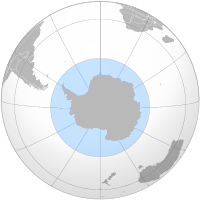
Photo from wikipedia
The spreading of Dense Shelf Water (DSW) from Antarctic coastal margins to lower latitudes plays a vital role in the ocean thermohaline circulation and the global climate system. Through enhanced… Click to show full abstract
The spreading of Dense Shelf Water (DSW) from Antarctic coastal margins to lower latitudes plays a vital role in the ocean thermohaline circulation and the global climate system. Through enhanced localized sea ice production in Antarctic coastal polynyas, cold and saline DSW is formed over the continental shelf regions as a precursor to Antarctic Bottom Water (AABW). However, the detailed fate of coastal DSW over the Southern Ocean is still unclear. Here, we conduct extensive passive tracer experiments using a circumpolar ocean-sea ice-ice shelf model to investigate pathways of the regional polynya-based DSW from the Antarctic margins to the deep Southern Ocean basins. In the numerical experiments, the Antarctic coastal margin is divided into nine regions, and a passive tracer is released from each region at the same rate as the local sea ice production. The modeled spatial distribution of the total concentration of the nine tracers is consistent with the observed AABW distribution and clearly demonstrates nine routes of the DSW over the Southern Ocean along its bottom topography. Furthermore, the model shows that while ∼50% of the total tracer is distributed northwards from the continental shelf to the deep ocean, ∼7% is transported polewards beneath ice shelf cavities. The comprehensive tracer experiments allow us to estimate the contribution of local DSW to the total concentration along each of the pathways.
Journal Title: Journal of Geophysical Research
Year Published: 2017
Link to full text (if available)
Share on Social Media: Sign Up to like & get
recommendations!